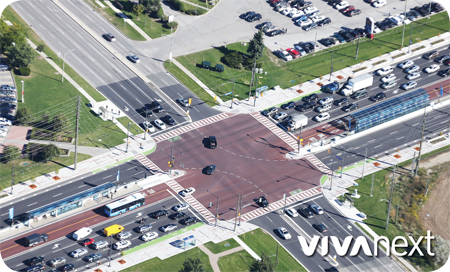
If you’ve ever done a major renovation on your home, you’ll know about all the permits and approvals that are needed before, during and after construction. So it will come as no surprise that in the world of infrastructure construction, obtaining the necessary approvals is a large and important piece of our work.
What makes obtaining the necessary permits and approvals for vivaNext a complicated task is the sheer number of elements that our project affects, involving a corresponding number of approving bodies and organizations. Every element that we touch or change plays an important role in our shared infrastructure, and is part of a larger, well planned system. So those checks are in place to ensure that construction changes will have no negative impact on the larger system of critical public infrastructure, which includes everything from storm sewers, hydro lines and gas mains to watercourses, railway crossings and highway exit ramps. It’s vital that none of those components and their proper functioning is affected by the implementation of the project.
So what are some of those permits and approvals? At a high level, our general design went through the comprehensive study and approval process of an Environmental Assessment long before detailed design even began. At a more practical level, there are all the obvious ones that are similar to what you’d need if you were building a new addition to your house. VivaNext stations and associated structures (like the elevator/stair towers on Highway 7 at Bayview Avenue) all need building permits from the local Municipality before construction starts. There are also ongoing approvals at intervals during construction such as structural, drainage and electrical inspections.
But there are more complex approvals and permits that are less obvious, yet are concerned with critical components, and getting signoff frequently requires a significant degree of planning and analysis. For example, the rapidways on Highway 7 are close to Highway 400, Highway 404 and 407 ETR, which are Provincial controlled access highways. Any roadway and intersection changes we may require within 400 metres of a controlled access highway need to be approved by the Ministry of Transportation. The rationale for this is to ensure that nothing in the design will result in drivers exiting the freeways being blocked by congestion, which in turn could interfere with traffic flow on the freeway itself.
For similar safety reasons, any roadway changes near railway crossings (both bridge crossings and level crossings) need to be approved by the railway companies. And the timing of traffic lights at intersections near level crossing also need to be carefully planned for and approved, so that traffic doesn’t get stopped on the railway during a red light.
Work near a watercourse or sensitive environmental feature requires various approvals in advance of any changes being made and to guide how work will be done. Environmental approvals and permits may require signoff from multiple bodies including the Ministry of Natural Resources, the local Conservation Authority – and depending on the significance of the watercourse, even the Federal Department of Fisheries or the Department of Transport. Working near cultural features, such as designated heritage buildings, cemeteries or potential archaeological sites, also requires considerable advance study and approval from the Ministry of Culture.
Getting permits and approvals is time-consuming but a necessary part of the project, and one that guides the work from the earliest stages of the project, until the final shovels of mulch are placed around new plantings along the boulevards. These processes ensure that every aspect of vivaNext is great for our community, both above and below the ground!










